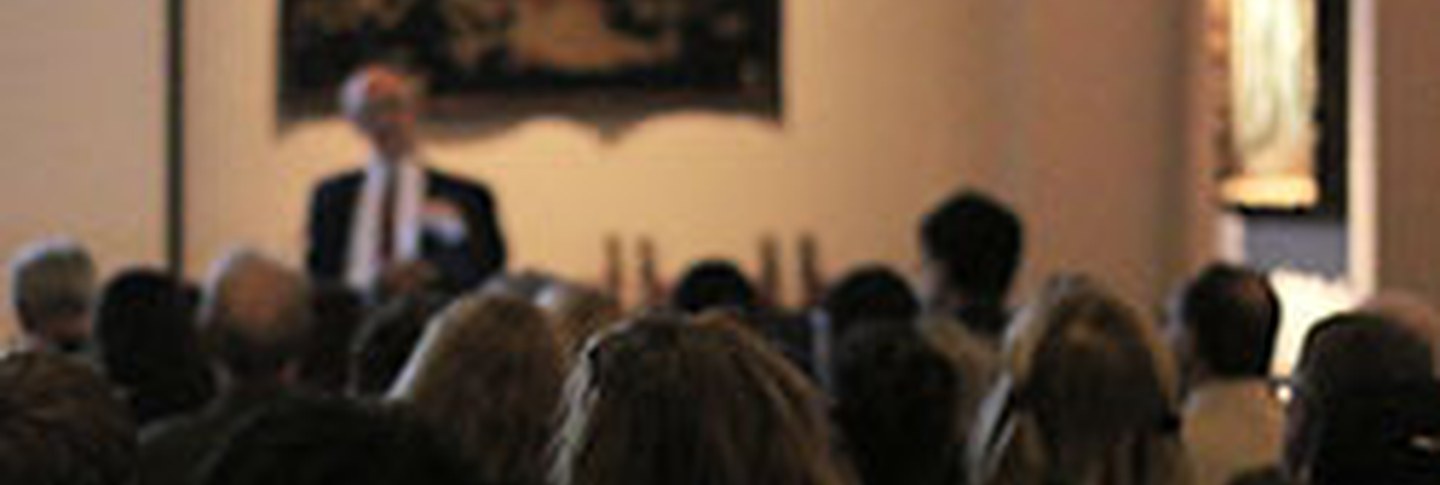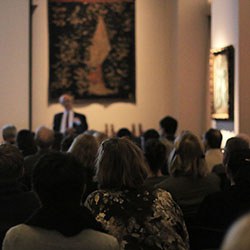The 2016 Garden and Landscape Studies symposium explored the many landscapes of the academy. John Beardsley and Daniel Bluestone presided over four groups of talks that considered not only central campuses but also designed landscapes managed by universities such as gardens, arboretums, and forests. The conference provided opportunities both to reflect on the importance of landscape to Dumbarton Oaks and to explore the complex and constant management of landscape and its larger role in our lives.
Day 1
Session 1: Campus core
The first section of the symposium considered the role of the core campus in the lives and education of students. Joseph Claghorn discussed the monoculture of elms and the significance of their departure from Harvard’s central landscape during the twentieth century and addressed the shifting landscape of the university and the commons. His talk suggested that more diverse communities—whether of plants or students—are also more robust communities.
John Davis and Karen Van Lengen discussed the pedagogical landscapes of vastly different educational institutions on either side of the Hudson River. Davis spoke about West Point and its attempt to use a particular landscape, the “engineer’s garden,” to address a national lack of expertise in military and tactical knowledge in nineteenth-century America. He discussed how nineteenth-century military educators used the “engineer’s garden” at West Point to teach soldiers and citizens to judge a multitude of varying situations. Davis discussed how cadets internalized the landscape of West Point and used its lessons in their later careers.
In contrast, Van Lengen stressed a different connection between pedagogy and landscape at Vassar College, which was an all-female institution until the late 1960s. Van Lengen focused on how Vassar students made their own landscaping program in response to their surroundings and interests in the environment. Students’ interaction with the landscape at Vassar helped shape the college as an early leader in ecology and conservation. As at West Point, students of Vassar carried conceptions of landscape into their future endeavors. But in the case of Vassar, this was more often in roles of stewardship and preservation of natural landscapes and habitats. Both Davis’s and Van Lengen’s talks addressed the gendered aspects of landscape in American education. They also opened questions about the difference between managing a landscape for practical education as opposed to research.
Session 2: Grove and Garden
The middle of the symposium gestured at Garden and Landscape Studies’ continuing effort to bridge history and practice. These sections were crucial in incorporating the perspectives of those who consider themselves primarily practitioners rather than scholars, educators, or historians. Mark Hough and Linda Jewell discussed the various conflicts and compromises involved in reconciling typologies between the campus and the garden at Duke University. Their talk delved into the challenges of balancing the different needs of student use, ecology, pedagogy, and the general public as they interact on the modern campus in America. Hazel Ruth Edwards spoke of the role of landscape as a nurturing force on the Howard University campus. Her talk was strengthened by images drawn from her own familial connections to the institution over generations. Gary Hilderbrand delivered a talk about the Olmsted brothers’ work in designing two campuses, which they hoped would have a transforming effect on the students and university by creating an atmosphere of quiet good taste for the development of character. Hilderbrand’s interest in the Olmsted brothers is informed by his current work developing the same campuses and extending their tree canopies. He noted his role has changed from theirs, as he needs to give voice to a larger number of interested parties involved in these spaces without sacrificing either the intention or the conviction of the projects. The speakers in this section often addressed the question of how to build flexible landscapes. They also concentrated on the need to predict the spaces of the future.
Day 2
Session 3: Import/Export
Another session of speakers addressed the role of campus and landscape in changing social and political contexts outside America. John Dixon Hunt spoke of the symbolic and literal changes in the design of buildings and landscapes in the new British universities, in contrast to the older Oxbridge models. Tianjie Zhang discussed the reconfiguration of Chinese university landscapes in the early twentieth century during the period of intense educational reform. Burak Erdim gave an extensive discussion of academy and landscape in Turkey during the Cold War. Finally, Hilary Ballon added a twenty-first-century perspective by speaking about her instrumental role in building NYU Abu Dhabi’s new campus. Her talk raised multiple issues around globalized education and the advantages and limitations of the exported American campus. She also suggested possibilities for the American campus model to adapt to different cultures and contexts around the world.
Session 4: Community, Conservation, and Environmental Management
The last section discussed community, conservation, and environmental landscape. Peter Alagona talked about the role of field stations in American university research and academic life. He addressed the importance of these spaces in conservation and ecology, particularly in light of California’s ongoing water crisis. Dino Martins from the Mpala Research Centre in Kenya stressed the importance of making scientific research applicable to the lives and challenges of small farmers in East Africa. He also spoke of the importance of understanding the effects of population growth and its impact on wildlife and conservation in the coming century. In conclusion, David Foster spoke about the history and legacy of Harvard Forest and Farm. Foster’s work spans multiple communities across the ecology, research, and education sectors, and both his and Martins’s talks addressed spaces that work as hubs of knowledge negotiating between different interest points.
Speakers at the symposium emphasized the importance of stewardship and ecology. They also noted the opportunity to teach students these concepts and values within the landscapes of the university campus. Among other topics, the symposium raised questions about the limitations of the neoliberal university in the twenty-first century, the increasingly urgent issues of elitism, and the treatment of women. They particularly highlighted the necessity of adaptation as the needs and uses of university landscapes change. Dumbarton Oaks, which transformed from a residence into a research institute with the transfer to Harvard in 1940, is representative of this need for continual adaptation.
As a complement to the symposium, the gardens staff recreated an early modern physic garden once planned on paper by Beatrix Farrand, which she based upon a physic garden in Padua.

